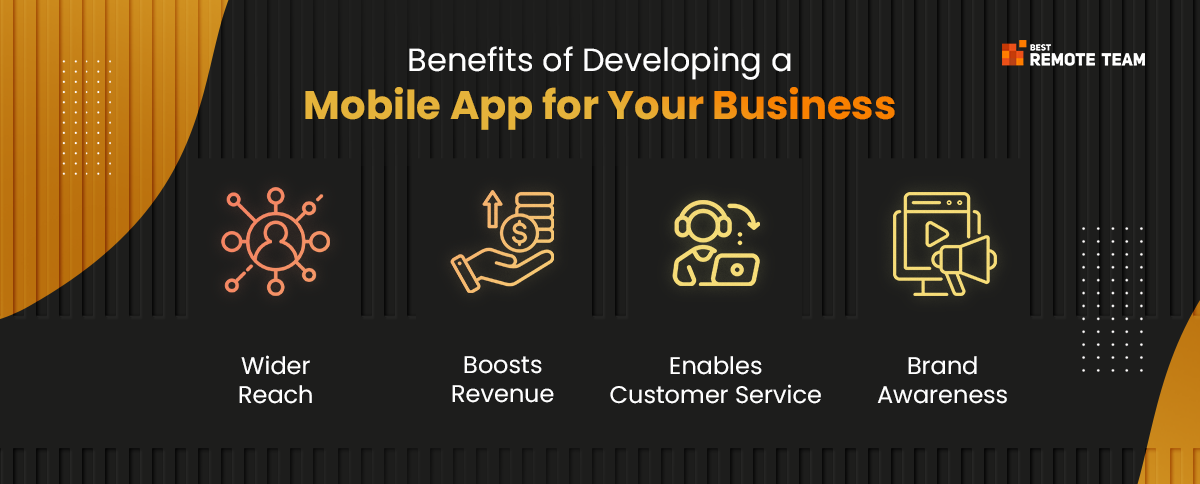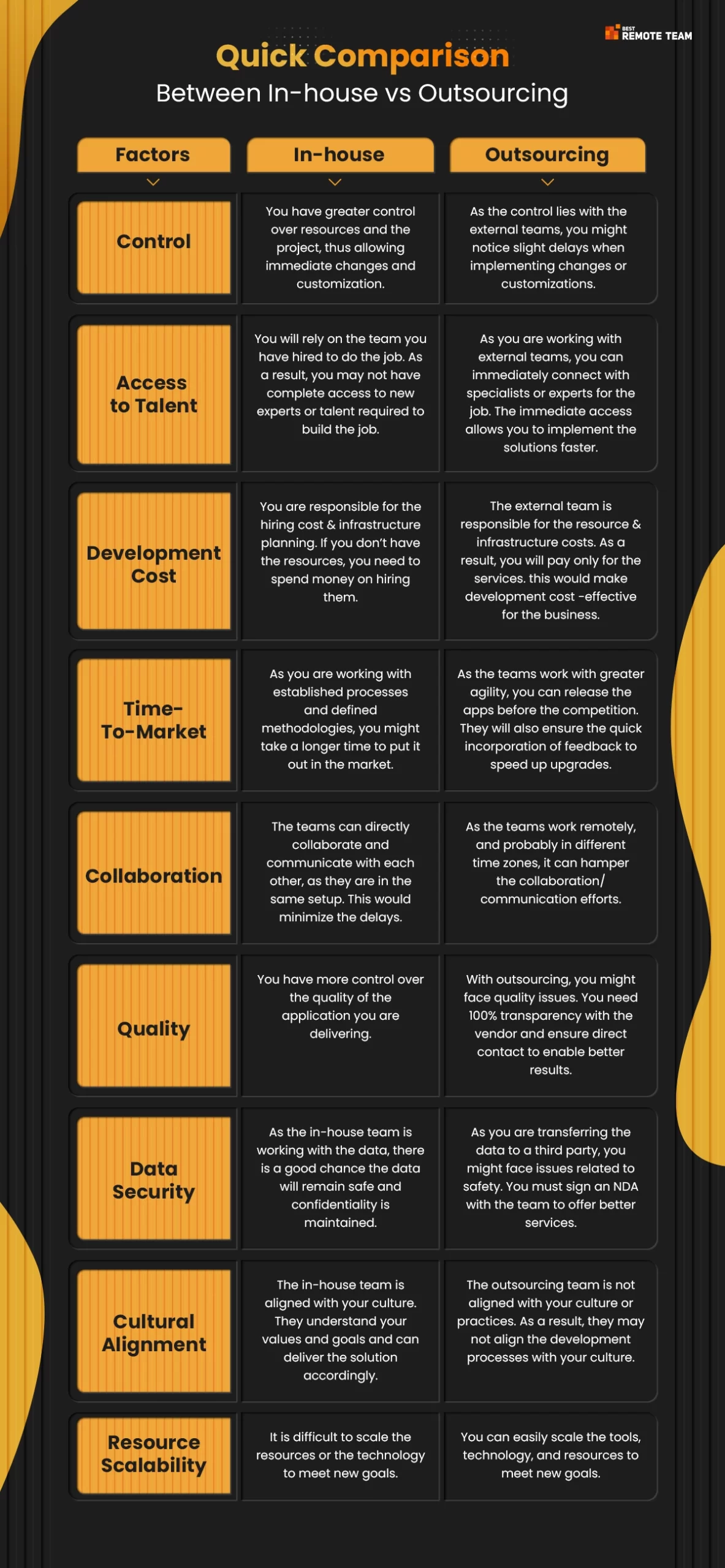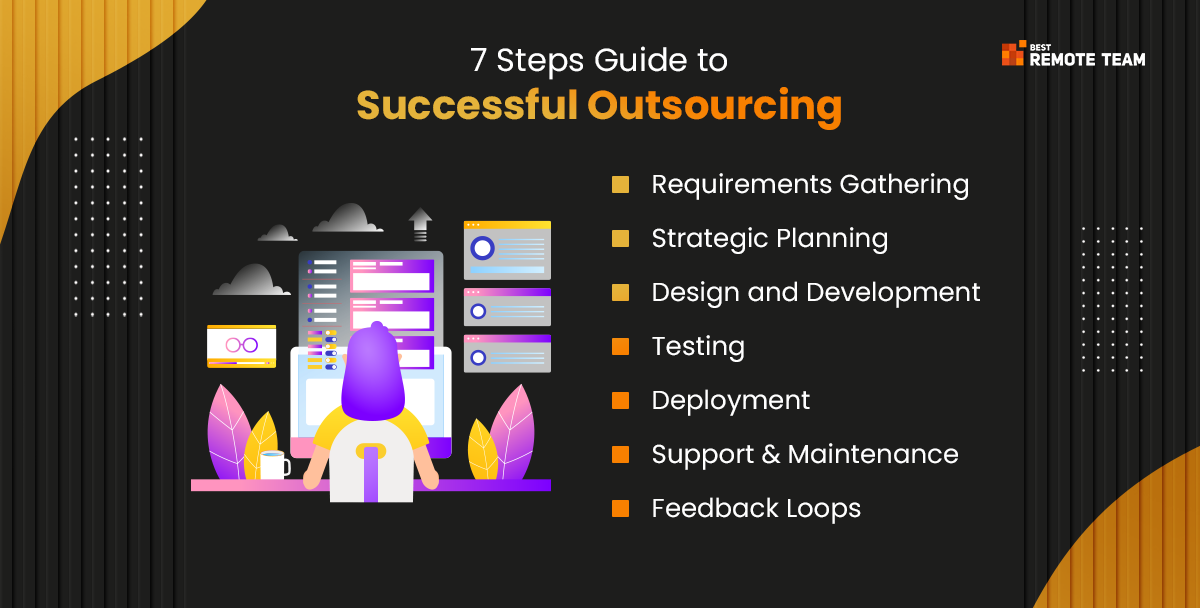How a Mobile App Can Benefit Your Business?
Before we jump into the topic of outsourcing, let’s understand why you need to build a mobile application.
1. Wider Reach
As your customers are present on mobile applications, you are likely to reach them even when they are busy. A tiny notification or even a small nudge would remind them of your existence. The mobile app will ensure that you reach all the people globally
2. Boosts Revenue
When you are a growing business, revenue can concern you majorly. Mobile apps offer a window of opportunity to reach your customers and convert them. For instance, when Dominos sends out a message, the customer might choose to purchase from them. This conversion occurs immediately, just enabling you to build your revenue.
3. Enables Customer Service
Prompt responses can increase customer experience. They would be more satisfied with your brand when your support team sends them a resolution immediately. This immediate gratification is possible when you invest in a mobile application for the business.
4. Brand Awareness
When you connect with your customers regularly, they are aware of your existence. This results in continuous reminders of your brand. Eventually, you will notice that the mobile app on the phone connects better with the customer. It will help build a positive image and a good impression.
The Right Development Choice – In-house or Outsourcing
There are a lot of opportunities you can create for your business with mobile app development. However, choosing the approach can enable you to build the right solution. Here we will compare in-house development with outsourcing to guide you toward a suitable choice.
In-house App Development
In-house as the name suggests is when you build apps with internal resources (technology, tools, and people). It is built with the help of the team members you have hired at your organization. This means, you pay the salaries, have bought the infrastructure, and will spend time dictating the movement of the application development.
The Key Features of In-house Development
- In-house development offers greater control over the projects. As a result, you have the ability to determine the project scope, the timelines, and even quality
- As the in-house team works in the organization, they are fully aware of the culture and biases. They would be able to build a requirement-specific and custom application to help attain business goals
- Confidentiality and data security are important for organizations. When you are working with the in-house teams, you get to ensure the data is safe and inside the organization.
- As the team is working within the organization, teams can collaborate. It would allow teams to discuss the discrepancies, avoid delays and communicate better about the solutions.
- When creating apps with the in-house teams, you can work out a long-term strategy to enhance maintenance abilities.
Pros and Cons of In-house Development
| Pros | Cons |
| More control on the development process, thus enabling quick changes | You may not get the skills needed to build the application. |
| Build more customized and feature-driven applications. | The in-house team may need continuous training and input from your end. |
| Increased data security and adherence to compliances. | You may need to invest excessively in building the infrastructure and hiring the resources. |
| Agility to develop apps and incorporate feedback to optimize the solution. | |
| Aligned to the organization’s culture. |
Outsourced App Development
When you hire external vendors or third-party companies to work on eCommerce app development needs, you outsource mobile app development. They will hire resources, plan the infrastructure and deliver the solutions in sync with the needs. They are responsible for the entire app development lifecycle of your business. That’s why several businesses prefer to outsource mobile app development in India.
The Key Features of Outsourced Development
- You hire specialized resources to carve the mobile application for your business. The resources would be proficient with current technologies, and tools. They would be adept with the methodologies and have an in-depth understanding of your industry
- When you outsource to another team, you are no longer responsible for creating the infrastructure or hiring the resources. You save a lot of money on labor, infrastructure, and development.
- It is easy to scale the team with outsourcing. You don’t need to hire resources; your development partner will add or remove people from the team. They can easily scale the technologies and tools needed for app development too
- You can release your apps faster into the market with outsourced development. It ensures fast and managed development.
- You have greater access to the development teams and required talent for app development.
Pros and Cons of Application Development Outsourcing
| Pros | Cons |
| You can save money on hiring resources and building the infrastructure as you get ready-to-use resources and services. | As the teams can be in a different time zone, you might face communication challenges. You must create communication protocols to overcome them. |
| It accelerates the time to deploy the applications owing to defined processes. | You may not have complete control over the project that you are building. |
| You can scale the applications faster with an outsourced team. | There is always a chance of delivering low-quality projects, which can cause a loss of reputation. |
| When you outsource app development, you can focus on core business strategies and processes. | As you are working with third-party vendors, you might face security and data safety risks. |
In-house vs Outsourcing: A Head-on Comparison
Step-by-step Guide to Outsourcing Success
Outsourcing can help you accomplish your goals. It is an effective way to ensure quick mobile app development and deployment.
However, you cannot succeed with outsourcing if you don’t follow all the required steps. Similarly, you must ensure you partner with the right team or company to bolster your mobile app success.
Having been chosen as a partner for several businesses across industries, we understand what leads to a solid partnership. Here are the steps that you must follow.
Step -1 Requirements gathering
Moving forward without a scope is like heading into a job without purpose or direction. This can happen if you haven’t built the work scope for your upcoming mobile app project.
Requirements gathering is the key to knowing what your team should build for the project. It can help you understand the problems your company is facing. You will also know the expertise you need and restrict the application to a tighter scope.
Requirements can establish what you need to communicate to the partner and the solution you need. For instance, if you want to create a productivity app for your internal resources, you must look at the challenges.
The pain areas can help you build the feature. From the feature list, you can derive the scope for the application and the technology stack.
Step -2 Strategic Planning
This is the stage when you and the development partner will sit together to define the plan for the mobile application. Every inch of the planning stage should be utilized to define the characteristics, purpose, and goal of the application.
In this stage, you are responsible for determining the tech stack to build the application. For example, if you want to build a cross-platform application, you must choose the framework. Similarly, you will define the UI framework, the approach for app development, and the backend structure during this stage.
This is also the time when your teams will invest in defining the communication protocol, budget, and timelines. You must also appoint the point-of-contact who would be responsible for monitoring app development.
Step – 3 Design and development
You have the technologies and tools at your disposal. You must utilize them to build the most aesthetic and functional application. You must begin app development by designing the solution.
Sketching a wireframe to position the key elements can help you transpire an effective interface. Once you have a defined wireframe, you can start working on the prototype for the application. This is also the time when you will build the app using the technologies.
If you are creating an MVP to test the market, you must align the development and deployment teams for better collaboration.
Once the frontend development is accomplished, you must work on building the backend. This is the time when you will work on constructing the database system, codebase, and reusable components. Once you have integrated the frontend and backend systems for the application, it is time to test the app.
Step – 4 Testing
By this stage, you have already implemented the front end and back end of the application. Similarly, you have also defined the APIs, integrated the communication, and built effective systems.
It is time to check your codebase and the UI you have built. You must also test whether the queries are being translated in the backend. Building effective test cases and going from there would enable smooth testing solutions.
You should choose to follow the unit-to-system testing approach for the best results. It is important to create a unique test case for each function and unit so that you understand the outcomes better.
It is equally important to use appropriate tools and technologies to test the solutions.
Step – 5 Deployment
Once you have tested the entire solution, it is time to use the deployment methods. You must have chosen them during the planning stage. Make sure you have optimized the app to improve its visibility.
It is very important to ensure you have used the right key phrases and descriptions. You must also optimize the app store with screenshots.
Whether you are planning cloud deployment or otherwise, following the best practices is a must. It will help you ensure the best solutions.
Step – 6 Support & Maintenance
This is another important part of thorough outsourcing. You must work on offering the right support after deploying the applications. It is equally important to help with app maintenance and services.
When outsourcing, make sure you have considered the exact ways you want support from your external team. Define the areas where the team would help you with maintenance.
You must seek support from the team concerning training and other requirements as well.
Step – 7 Feedback Loops
Implementing feedback in real time can help you optimize the applications. You must create effective feedback loops while outsourcing. This would enable both companies to ensure that the customer is heard and their needs are fulfilled. You must plan your feedback loops completely before moving forth.
Challenges with Outsourcing
While outsourcing has a lot of pros, you might face several challenges during implementation.
- As you don’t directly work with the team, you might not be able to view the progress. It is challenging to track the team’s performance. This can be challenging if you are experiencing bottlenecks or issues during the project
- You might experience resistance from within the organization as they are not ready for the change. They might be insecure due to outsourcing
- You might experience internal conflicts and raising overlap in the workflow. This is because a lot of activities are conducted in-house as well as via outsourcing
- If you have not defined the contract clearly, you might experience issues working with the outsourcing company.
Conclusion
Outsourcing is a great way to enhance the capabilities of your application with the help of an experienced team. You will notice specialists working on your application and offering exceptional solutions. It is important to choose a suitable mobile app development company for your outsourcing needs.
While you might miss control, proper tracking and communication protocols can help you keep up with the progress. It is important to choose an appropriate outsourcing partner and streamline the development processes.
Best Remote Team can help you with the suitable team and expertise to build your mobile application. Connect with our teams to access the diverse talent pool.









